Benin is probably the Gulf of Guinea’s least-known nation. Though small with an area of 113,000 square kilometres and a population of 9 million, Benin is charming and enchanting. Our truck reached most corners of Benin bringing me to the northern upland, the south and the coast. My visit to the Royal Palace of Abomey (a World Heritage Site), the Pendjari National Park, Ganvie, the Somba villages, Ouidah and Grand Popo all exceed my expectations.
Day 21 (Wednesday, January 25): Tanguieta – Boukoumbe – Somba village(150km; 3 hrs)
Peter decided to go to the hospital for a test. It turned out that he too had malaria. We waited anxiously at the hotel and Mike and Ant worked out various options. We were relieved when Jess, Naomi, Lisa and Peter came back and were fit enough to continue with the journey. The truck was back on the road at 3pm.
Mike was given poor information on the location of the eco-lodge run by Eco-Benin. As a result, we drove all the way to Boukoumbe close to the Togolese border only to realise that we had long passed the lodge. It took us almost another hour to drive 20km to reach the village and the lodge is built in the style of Tatas-Somba. It turned out well as the scenery to Boukoumbe is magnificent. We had an interesting guided walk to a village!
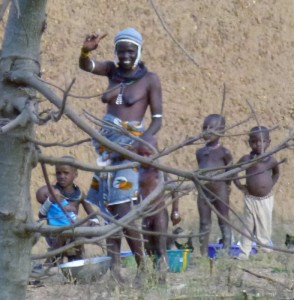 |
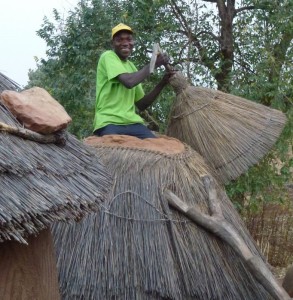 |
Dara did not feel well and planned to take a malaria test the following day. We had the window open and the door shut. I found it hot and could not sleep well. We had nice couscous for dinner prepared by a French lady volunteer from Brittany. The lodge is a community project which only commenced operation last year. I hope more visitors will come to see this wonderful Somba country thus benefitting the local community.
Day 22 (January 26 – Australia Day): Somba village –Natitingou – Abomey (400km; 10 hrs)
I got up before 5am, left the room which is like an oven and sat in the corridor to sort my photos. Before breakfast, I joined Barb and Anne-Maria on a short walk around the village. It’s nice to take a closer look at the toy-like houses! I spoke with a villager who looked content with his life though he was not rich by any standard.
As it is the Australia Day, Gary placed an Australian flag in the truck and put on a tap with funny Australian music! We set off at 8:30am and had an hour free time at Natitingou. Then we had to spend the whole day on the road and only reached Abomey after 7pm. Dara accompanied by Rick who is fluent in French, went to the hospital for a malaria test.
Day 23: Abomey – Ganvin (200km; 5 hrs)
I accompanied Dara to the hospital to get the test result before breakfast. The result was negative i.e. no malaria. I am impressed by the spacious and clean facilities at the hospital.
We set off at 9am for Ganvin. I am surprised that the road south of Abomey leading to Cotonou (the commercial centre) and the coast is not too good. We drove some 45 minutes on the red piste before getting back on paved road. The expressway is under construction/reconstruction. We arrived at Abomey-Calavi after 3pm and were met our local guide, Mathius.
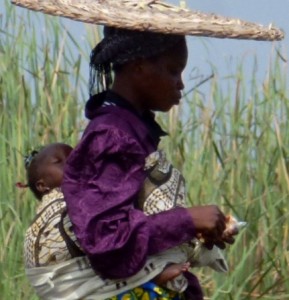 |
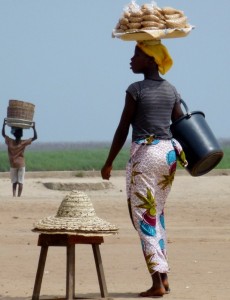 |
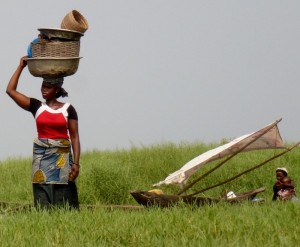 |
Ganvie is inhabited by the Tofinu people. Their ancestors arrived here escaping from the slave raids of the Dan-Homey army. As they were forbidden for religious reasons to extend their attack over water, the Tofinu people were safe and started making their living primarily by fishing.
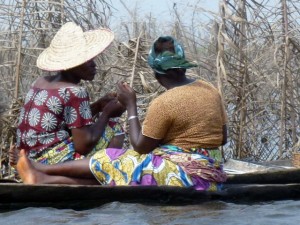 |
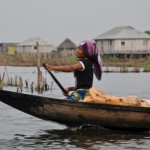 |
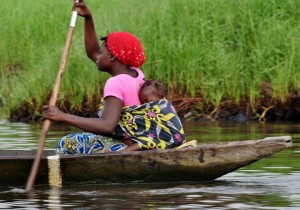 |
Ganvie is said to be Africa’s largest lake village with a population of 30,000. Our motor boat skimmed the shallow water of the lagoon. We watched dozens of fisher men fishing with traps, or around nets set up along underwater fences or in the middle of the lagoons. We arrived at Ganvie 1 and saw hundreds of flimsy rustic wood and thatch houses built on tall stilts. The scenery is picturesque though the water is filthy as the sewage and waste water just flow through holes into the lagoon. Then we had a boat tour of Ganvie 1 and 2 watching hundreds of locals traversing the waterways in their boats and numerous kingfishers and herons along the shores. The whole settlement is lively and colourful. Most locals do not like to be photographed. I therefore have not been able to take pictures of babies sleeping sweetly on the back of their moms, tiny kids with their paddles maneuvering skillfully their way in the busy waterway and women selling their products in the floating market.
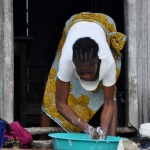 |
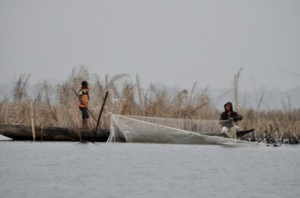 |
 |
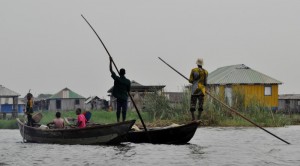 |
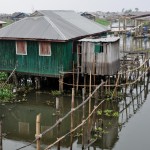 |
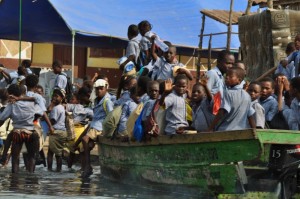 |
We spent a wonderful night at Auberge Carrefour run by Monica. I had a most satisfying dinner with a big tasty grilled fish, rice, spaghetti, couscous and chips! I was so happy that I had two large beers for the night!
Unfortunately I had another sleepless night as the room was very hot. My right arm was badly bitten and my skin was itchy.
Day 24: Ganvie – Cotonou – Ouida – Grand Popo (100km; 4 hrs)
I got up before 6am as I could not sleep and there were a lot of noises outside. I sat happily by the steps watching life on the busy waterway. After breakfast, we took the boat back to the pier and drove off to Cotonou where we had three hours’ free time. As I had to cook that evening, Jens, Naomi and I had to go shopping. Then I spent the remaining time on internet. We were back on the truck and set off for Ouidah at 1pm.
Mike got lost and I had a tour of Cotonou, the commercial centre of Benin, on the truck. There are lots of buildings from the colonial era in all sorts of styles and some new government buildings. The port seems busy and the city looks tidy by comparison to those I have seen in Nigeria and Cameroon.
We finally found our way to the beach road (a red piste) and arrived at the ‘Door of No Return’, a monumental arch decorated with bas-relief images and metal sculptures of slaves in shackles.
The next stop was the Museum of History of Ouidah housed in the Portuguese fort of Sao Joao Batista built in 1721. The forts built by the French and British had all gone. There are not many exhibits. I found many of the replicas of maps are de-coloured and incomprehensible. Our lady guide is imposing and gave us a quick introduction stressing on the influences of slaves including voodoo on Brazil and the Caribbean.
I find Ouidah laid-back and atmospheric with the tree-lined main road paved in stones. The colonial architecture in ochre with cracked facades, sagging wooden porches and shutters are enticing. Loud music brought the sleepy town to life and many people were sitting at local eateries or had a snack by the street food stalls. In the centre, the colourful basilica located opposite the python temple also gives the place a unique sensation and mix: voodooism Vs Catholicism; rustic and fetish Vs western civilisation. There is so much to see and to experience but we were hurried away in our truck to Gran Popo.
My cook team spent the next two hours busy in preparing the dinner. I seldom cook at home but had to spend over an hour chopping up vegetables (carrots, pepper, cabbage, egg-plant and onion). Then I spent half an hour to stir-fry the vegetables. As there was no cooking oil, we had to ask Mathius to bring oil from his home. The wok is small. Hence I had to fry small portions of vermicelli together with cooked vegetables each time. As a result, our dinner with chicken and stir-fry vermicelli and vegetables was served after 8:30pm. Jens, Naomi and I were pleased that the group enjoyed the meal (probably everyone was too hungry!). I kept the left over for the following day and ate to my heart’s delight the following day!
We spent three nights at the camping ground of L’Auberge of Grand Popo. I got a room for CFA13600 (about US$24) a night in a nice room with a fan, a toilet and shower in a beautiful colonial building. The bed is firm and I had my first good sleep for over a week inside a mosquito net. I slept like a baby and got up at 8:30am the next day!
Day 25-26: Grand Popo
Grand Popo was once an important port at the height of the slave trade. It has some colonial buildings and miles of idyllic beach. In brief, I had a wonderful time in Grand Popo.
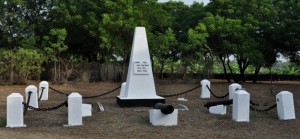 |
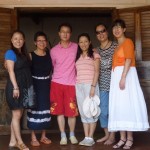 |
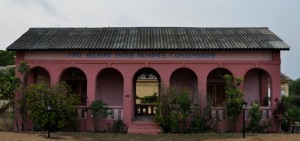 |
First, I had a lovely morning walk along the beach and spent most of the day sitting in the veranda of the hotel by the beach preparing my travelogue. The setting is most idyllic and atmospheric with coconut and palm trees, a large veranda built in colonial architecture, soothing rhythm of the waves and me with my computer! I was surprised to meet five Mainland Chinese who are working in Benin.
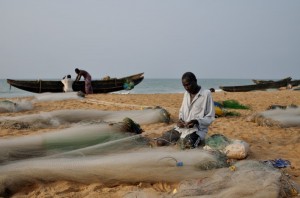 |
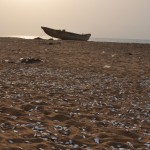 |
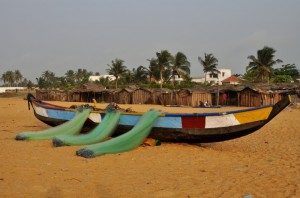 |
Second, Mike arranged us to see a voodoo ceremony which lasted for two hours in a village in late afternoon on Day 25. A group of villagers beat the drums and other musical instruments under trees and a few children danced. Slowly four voodoos(according to Mathius, they are the spirits of a tree and the dead) belonging to the same family comprising of father, mother and their son and daughter) in a huge and colourful cone-shaped straw cover appeared and they swirled around and around. Then sacrifice was offered to one of them and magic was performed when a live chicken was killed and cooked in a few minutes. Hundreds of villagers gathered around to dance, cheer and sing. I do not know how to describe what I have seen. When the cover was removed, I saw a small stone of one foot high on the ground. Is it mystical power or someone performing magic? The men removed the cover of a couple more voodoos and I saw they all had different shape, size and material. I am puzzled and shall read up when I have time.
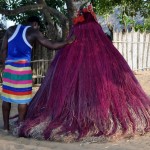 |
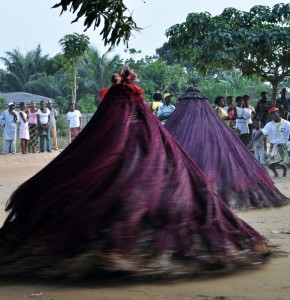 |
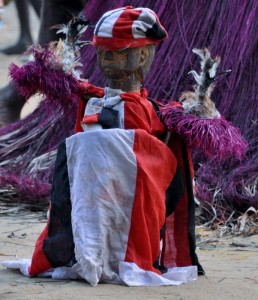 |
Third, Naomi, Angelito and Charlotte and I joined a canoe tour on Day 26 to visit the Heve village on the Mono River. The canoe made out of a single trunk is sturdy and most comfortable. We first went to see mangroves where the fisherman catches and keeps his fish and shrimps in nets. I saw a beautiful blue kingfisher as well. Then we crossed the river and arrived in the Heve village. There are many voodoo temples. We visited a family, saw the Portuguese house built by those returning from Brazil and a bunker built by the French during the World War I. Mathius then took us to call on the king of Grand Popo who speaks both French and English. He invited us to come back for the Voodoo Festival in January. This was the best tour on this trip!
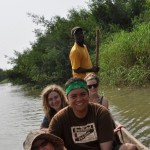 |
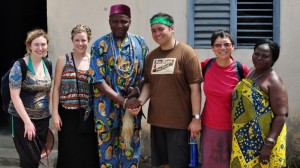 |
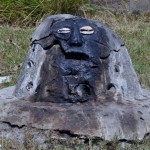 |
Day 27 (Tuesday, January 31): Grand Popo, Benin – Lake Togo, Togo (30km; 2 hrs)
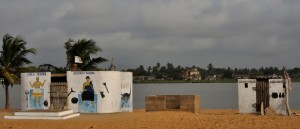
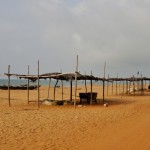
I left the hotel at 7am and had a pleasant walk for two and a half hours along the river on one side and the sea on the other. Then it was time to pack up and leave. We set off around 11:30am and took just half an hour to reach the Benin-Togo border.
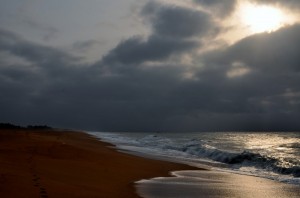 |
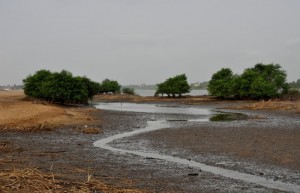 |
Remarks
I like Benin which is very different from the African countries I have visited so far. According to the original itinerary, we would spend 6 days in Benin. But as a result of the problems in Nigeria, I spent some 12 blissful days in Benin.
I find the idiom “The total is more than the sum of its parts” is a good description for Benin.
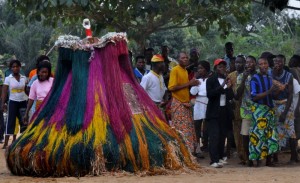 First, its landscape and wildlife at the national park are not extraordinary. I have seen more animals in national parks in Namibia and Kenya. But the bush camping under the stars beside a river with the howling of dozens of hippos is wonderful and memorable. The Somba country in the northwest is interesting and picturesque. I am glad to see the people in Somba, Gavin and Heve still leading their own way of life and not yet spoilt by mass tourism like the tribes I have visited in Ethiopia. I hope Eco-Benin and the government would succeed in making the most out of tourism without ruining the spirit and culture of the land and the people.
First, its landscape and wildlife at the national park are not extraordinary. I have seen more animals in national parks in Namibia and Kenya. But the bush camping under the stars beside a river with the howling of dozens of hippos is wonderful and memorable. The Somba country in the northwest is interesting and picturesque. I am glad to see the people in Somba, Gavin and Heve still leading their own way of life and not yet spoilt by mass tourism like the tribes I have visited in Ethiopia. I hope Eco-Benin and the government would succeed in making the most out of tourism without ruining the spirit and culture of the land and the people.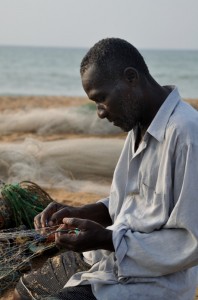
Second, Benin is definitely one of the better administered countries in Africa. The country as a whole looks tidier and cleaner than Nigeria and Cameroon. The hospitals that I have visited are clean and respectable. The roads are paved and generally good (though the section south of Abomey is under construction). Land along the roads is mostly cultivated for cash crops or under subsistence farming. Villages along the road and those in the Somba region are provided with water-wells. I am impressed by the number of schools seen from the truck. They look tidy without broken windows (!) and have similar layout and structures in ochre/orange/white colour. The children in uniform look smart. I particularly enjoy watching dozens of children in uniform paddling in their boats in Ganvie.
Third, the people are very nice and friendly.
Benin though small and underdeveloped has so much to offer. I am glad to have a better feel about the people and the place. I wish the group had stayed in Ouidah for one night as originally planned as it looks charming and atmospheric with plenty to see and do.
The people I have spoken with seem to like the present government. I hope Benin will remain blissful, charming and stable thus facilitating steady economic and social development. I would like to revisit Benin if I am back to West Africa one day.


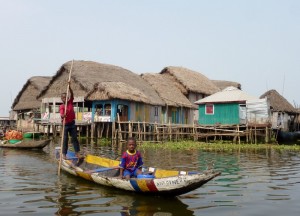
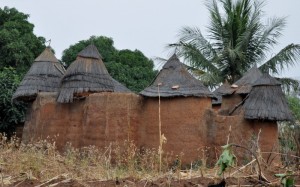
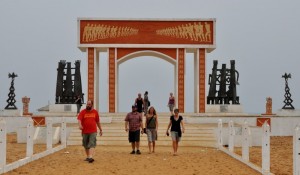
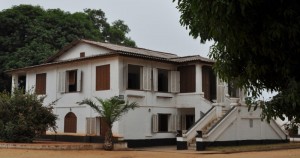
This is the first time I learnt of ‘Voodooism’.
Did you find out the secret of the magic in that voodoo ceremony?
From now on, I remember you know how to cook stir-fry veggitable chicken with vermicelli..